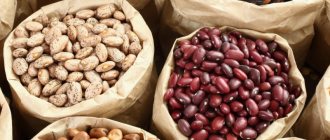The juicy pulp of aromatic sweet watermelon is pleasantly refreshing in the heat and quenches thirst. Watermelon is a source of iron, potassium, magnesium, folic acid, vitamin C and fiber. Its use allows you to improve your body health and lose excess weight. You want to enjoy delicious watermelon not only during the season. In this article we will talk about how to choose and how to properly store a watermelon, how long you can store a watermelon in the refrigerator, and also answer other important questions.
With the right approach, you can store watermelon in the refrigerator for a long time.
How long can watermelon be stored?
Those who consider watermelon exclusively a summer delicacy are wrong. The thick peel serves as a reliable protection against bacteria and is able to keep the sweet pulp fresh for quite a long time - up to 6 months. You just need to provide suitable conditions, and nature has already taken care of the rest. So your favorite berry may well join tangerines and Olivier on the New Year's table.
Naturally, we are talking about whole fruits. After opening, the life of watermelons, alas, is very short - two days in the refrigerator and up to six hours at room temperature.
Where to store watermelon juice?
For cocktails, you can make watermelon juice and freeze it.
Fresh juice is poured into a suitable container that closes tightly and does not allow moisture and odors to pass through. Then place the juice in the freezer ; it is better to allocate a separate drawer for this.
You can enjoy fresh watermelon juice until the next harvest.
You can learn about the terms and rules for storing honey here.
How to preserve whole berries
Remember the fairy tale “The Twelve Months”? You, like the heroine of a fairy tale, have a chance to cheat time and briefly be transported to sunny August on a cold winter day by arranging a watermelon fiesta for yourself.
Shall we try together? I’ll tell you how to store watermelon correctly, and then you can share your impressions in the comments to the article.
Suitable fruits: characteristics
Correctly chosen fruits are 70% of success. It is important to be vigilant at this stage. Here are some tips to help you cope with this task.
- Choose berries without scratches, cracks or dents. The peel should be smooth and even. “Wounded” and “crippled” specimens have no place in the squad of long-livers!
- Don't pick fruits that are too big or small. Ideal weight is about 5 kg.
- The berries must be ripe. Don't expect them to ripen during storage. Overripe ones are also not suitable. I hope everyone knows how to choose a ripe and tasty watermelon?
- The thick-barked late varieties last the longest - these are: Astrakhan Striped;
- Dessert;
- Mariupol;
- Peasant;
- Chill;
- Volzhsky.
You should make supplies for the winter at the end of the season - in late September or early October. In this case, there is a chance to preserve them until winter, or even longer.
Tip: buy several watermelons from the same batch of about the same size - a couple for eating, the rest for storage. This way you can evaluate their ripeness and taste.
Before storing, the fruits must be thoroughly and carefully washed and dried.
Optimal storage conditions
First you need to decide on a storage space. A cellar is best suited for this purpose. If you are a city dweller, do not despair. You can also find a suitable place in your home - an empty glass balcony, for example. Or place your green charges in the garage, if possible.
Regardless of the storage location, certain rules must be followed:
- The temperature in the storage should be within 2-8 °C, optimal humidity 70-85%.
- Isolate the room from bright light and ensure good air circulation.
- Keep the watermelons spaced apart so they don't touch. Also, keep them away from vegetables, especially potatoes.
- Do not place berries on a hard surface to avoid injury. Lay it with cotton cloth or straw.
- Turn over and inspect your supplies every two days. Remove damaged and damaged ones.
Long term selection criteria
The key to preserving a watermelon for as long as possible is its original condition. Regardless of how long it will be consumed, you need to evaluate it according to two criteria:
- Inspect the peel for external defects. These include cracks, dark spots, deep scratches, and dents.
- Assess the safety of melons. Shiny skin with bright colors and well-defined stripes (in the corresponding varieties) indicates that they were fed with safe organic fertilizers. A matte peel and a blurred pattern on the surface are signs of a large amount of nitrates in the pulp.
If you plan to eat watermelon in the near future, it is cost-effective to choose large, early and mid-season varieties.
For long-term storage, it is better to choose berries collected in late September - early October. They are small in size, weighing on average 6 kg and have a thick skin.
In any case, the culture must be well matured. The following signs indicate sufficient ripeness:
- “Ringing” when you hit the skin and a crackling sound when squeezing.
- A dried dark ponytail and the same base.
- Large yellow spot on the side.
- The mesh is gray at the end opposite the stalk.
Round watermelons are considered “female”, elongated ones are considered “male”. Round fruits are sweeter and contain fewer seeds.
Long-term storage methods
Let's look at seven ways to store watermelons.
In a refrigerator
The simplest and most versatile way to store watermelons is to put them in the refrigerator, after wrapping them in newspaper and laying them on a natural fabric bedding. Its significant drawback is the lack of free space. Well, there is a risk of damaging the berries during hungry raids on the “temple of food abundance.”
On the grid
If space allows, I advise you to use this method first - you will save energy and avoid getting your hands dirty. Watermelons need to be wrapped in cotton cloth, placed in a net and hung on a hook so that they do not touch the walls, floor, cabinets and other objects. Looks very original!
In sand
Pour a small layer of sand into a wooden box or barrel, place the watermelon with the stem down and completely cover it with sand on top. Make sure that the sand is dry and uniform, without sharp fragments of stones or glass. Alternatively, you can use ashes or dry grain. Finally, close the container tightly with a lid to prevent moisture from entering.
In clay
The beneficial qualities of clay have been widely known since ancient times - in addition to strength and plasticity, it has good bactericidal properties. Mix clay with water to a paste-like consistency and coat the fruits with it. You can use a brush, or you can do it with your hands. Let the clay dry, then repeat the procedure. You should end up with clay armor approximately 1.5 cm thick. After such a “mud wrap”, your berries will remain youthful and fresh for a long time.
In paraffin
This method is a fire and injury hazard, so be careful! Melt paraffin or wax in a water bath to a liquid consistency and carefully cover the watermelons with it using a brush. The protective layer will protect them from contact with air, moisture and harmful microbes. After drying, carefully place the berries in the place prepared for storage.
In water
No, this is not a joke - watermelons can really be stored in such an unusual way. To do this, you need to place them entirely in a vat or bath with cold water. The water should be changed several times a month and should not be allowed to freeze.
In the moss
Collect moss from the forest and dry it thoroughly in the sun. Place a layer of moss in the prepared container and place the watermelon in it. Also fill the free space on the sides and top with moss and cover with a lid.
Now you know everything about long-term storage of watermelons. Don’t forget to use this knowledge during the coming summer season, but in the meantime I’ll share with you the secrets of how to extend the life of already cut fruits.
Terms and conditions of storage
The shelf life of watermelon depends on its variety, quality and storage conditions. Thin-skinned berries of early varieties will not spoil within 60 days. Late watermelons can be stored for up to 3-4 months. The following indicators are optimal for storage:
- Air temperature from 3 to 5°.
- Humidity 65-85%.
- Good ventilation.
- Darkness.
If the specified conditions are met, the “lifetime” of watermelons will be maximum. In such conditions, they do not ripen during laying.
At room temperature, watermelons will not lose freshness for 1-2 months. At 20-25° above 0, unripe specimens will ripen, and well-ripened ones will begin to deteriorate within a week. Damaged watermelons are stored for 1 to 3 weeks.
The best place to store berries in an apartment in the summer is the refrigerator . In autumn and winter, the fruits can be placed in a cool pantry or on an insulated loggia. In a private house, melons are placed in the attic, cellar, or summer kitchen. It is important to follow these rules:
- The fruits should not touch each other.
- Every 2-3 days, watermelons must be turned over so that they do not lie on their sides.
- Damaged specimens are immediately removed so that others do not become infected from them.
- Cultures should not be placed on a hard surface. Racks and boxes with watermelons should be covered with a layer of straw, sawdust, sand, and burlap.
- Melons are placed away from other vegetables and fruits, which can speed up their spoilage or impart an unpleasant odor to the pulp.
It is convenient to store watermelons hanging in any suitable room. The fruits are wrapped in natural fabric, placed in a vegetable net and hung on a hook driven into the ceiling.
How to Preserve a Cut Watermelon
The sweet, juicy pulp of watermelon is enjoyed not only by millions of people around the world, including you and me, but also by countless microbes and bacteria. That is why, after opening, its shelf life does not exceed a couple of days.
Did you know that there are varieties with white, yellow, orange, green and even black flesh?
Ideally, watermelon is best eaten immediately after cutting, but given its size, this is not always possible. Here are a few rules, following which you will not have to suffer from pangs of conscience, throwing away a spoiled, half-eaten dessert.
- Wash the fruit thoroughly before cutting, preferably with soap.
- Open it immediately before use.
- Do not leave the watermelon at room temperature, much less in the sun, under any circumstances, even for half an hour!
Does watermelon spoil in the refrigerator?
Even if all the conditions for selecting and storing watermelon are met, it can spoil in the refrigerator. This occurs due to the fact that bacteria in the air use the fruit pulp for active reproduction. The result is the processes of souring and rotting .
If there is the slightest change in the color, smell, or appearance of the watermelon, it should be thrown away , otherwise there is a risk of severe food poisoning.
You cannot simply cut off the damaged part, because the microbes have already spread throughout the pulp.
To prevent the watermelon from spoiling quickly, you should follow the storage rules : clean dishes, packaging in film or container, correct temperature conditions.
Storage methods after opening
In a refrigerator
Uneaten fruit should be stored in the refrigerator. To do this, place it cut side down on a plate or tray and wrap it all with cling film. Make sure that the pulp does not come into contact with the film, otherwise it will become slippery and tasteless.
How long can you store watermelon this way? No longer than two days, after which it is no longer suitable for food, even if the taste is still normal.
In the freezer
Another way to preserve cut watermelon is to freeze it. First separate the pulp from the peel and remove the seeds, then place it in even pieces in a container and close the lid tightly. You can also beat the pulp in a blender and freeze it in liquid form.
Watermelon can be stored in the freezer for up to 10 months. But, unfortunately, during long-term frozen storage it loses its taste and after defrosting it is only suitable for making drinks.
Why I refused to buy large watermelons
I deliberately refused to buy large watermelons (I consider fruits weighing more than 5 kg). The reason is not only that we do not have time to eat such a berry on time.
Have you noticed that giant berries tend to be crumbly inside? Having grown to large sizes in the melon field, they simply become overripe and lose their beneficial properties. In addition, they are completely unsuitable for storage, either whole or cut.
I strongly advise everyone who buys a watermelon at the market to soberly assess their own strengths. If you have time to eat the berry in a short time, then take it; if not, it is better to give preference to medium-sized fruits.
Found a violation? Report content
Useful properties of watermelon
Watermelon consists of 90% water and has a pleasant calorie content - 38 kcal/100g. Its pulp contains negligible protein and virtually no fat. Watermelon pulp contains fiber, pectins, hemicellulose, vitamin B1, B2, C, PP, folic acid, provitamin A, carotene, manganese, nickel, iron, magnesium and potassium, 5-11% easily digestible sugars, as well as a little ascorbic acid acids, carotene, quite a bit of thiamine, riboflavin and nicotinic acid. Watermelon pulp is rich in organic acids, which are good for stimulating digestive and metabolic processes. Watermelon seeds, in addition to concentrated pulp components, also contain carotenoids, tocopherols, B vitamins (thiamine, riboflavin, nicotinic acid, folic acid), a wide range of macro- and microelements, incl. zinc and selenium, and polyunsaturated fatty acids. The oil contained in the seeds is rich in vitamin D. Due to its juicy pulp, watermelon has a diuretic property; it is recommended to eat it for edema caused by diseases of the cardiovascular system and kidney disease, incl. presence of stones.
Useful articles for gardeners and gardeners
Fried eggplant recipes, quick and tasty
Eggplants: quick and tasty stewed recipes
Eggplants like mushrooms recipes, quick and tasty
Eggplants for the winter are like mushrooms without sterilization
Nutritionists believe that you can consume 2-2.5 kg of watermelon per day. For example, in case of nephrolithiasis (urate and calcium oxalate stones in the kidneys and bladder), these salts precipitate during the acidic reaction of urine, while watermelon contributes to their transition to a more soluble state, and its diuretic effect accelerates the removal of salts from the body. In this case, nutritionists advise eating watermelon evenly, in portions, even at night. There is no better food for patients with sclerosis, gout, hypertension, arthritis, and diabetes than watermelon. Watermelon fiber has a general strengthening effect, stimulates intestinal motility, and helps eliminate excess cholesterol from the body. Watermelons perfectly quench thirst and help remove toxic substances from the body.
Effective facial skin care products are prepared based on watermelon. With regular use, its condition improves noticeably. Let's look at four recipes for homemade cosmetics based on watermelon.
Temperature
At what temperature can watermelons be stored? When storing watermelons, strict temperature conditions must be observed. The optimal temperature is from +1°C to +3°C.
The temperature should not be allowed to fall below zero or rise above the specified values, as in this case the berries will spoil.
Relative humidity should be no more than 80-85%.
Sometimes they try to freeze watermelon pulp, which, of course, will not preserve its original taste, but will at least allow it to be used for making cocktails or juices.
When using shock freezing, the taste is preserved better, so this method is also used.
How to cut and how much you can eat per day
The traditional cutting of this product is wedges or slices. However, as practice shows, eating watermelon fruit in slices is not always convenient (especially for children). It is best to cut the watermelon berry into squares - this shape is more convenient and allows less contamination of the face with juice. Eating watermelon with a spoon is also becoming popular - the berry is cut into 2 or 4 parts, and the pulp is eaten with a spoon (this is the most acceptable method for children).
The rate of consumption per day depends on the individual characteristics of each person’s body - if you do not have problems with the digestion and excretory system, you can eat at least the entire product. The daily norm for an average person with a normal metabolism should be 800-1000 grams of pulp (this is one small watermelon). Children over three years old are recommended to give no more than 3 slices per day.
Moisturizing and toning mask
Creating a moisturizing face mask from a watermelon fruit is very simple - you just need to cut the berry and apply the crumb to clean facial skin. After 15 minutes of keeping this mask on your face, you will see that the pores have narrowed, the oily sheen has disappeared, and the skin itself has gained elasticity. After using the mask, it is recommended to apply a light moisturizer to your face to consolidate the effect. You can also make an excellent tonic from the watermelon fruit - to do this, squeeze the watermelon juice into ice molds and make watermelon ice. If you hit your face with such an ice cube every morning, it will help relieve fatigue and excessive swelling of the face, and also reduce dark spots and bags under the eyes.
Cleansing mask
To prepare an effective cleansing face mask, you need:
- dry the watermelon seeds and grind them finely,
- dilute the resulting watermelon powder with warm water (you can add a few drops of your favorite essential oil),
- Apply the resulting product onto pre-steamed skin using massaging movements, leave for 15 minutes,
- after 15-20 minutes, wash off the mask with cold water.
For hair care
Organic acids and vitamins contained in watermelon successfully restore and treat damaged hair structure, improve hair growth and eliminate dandruff, and also reduce the likelihood of excessive hair loss. The most effective hair products are:
- Onion juice mask. Mix watermelon and onion juice in proportions 2:1, add egg yolk and a teaspoon of honey. Apply this product before washing your hair for 15 minutes. Rinse off with cool water.
- Refreshing shampoo. Add 10 drops of menthol essential oil to 100 grams of watermelon juice, distribute over the entire length of the hair and rub into the roots. This product perfectly cleanses hair of impurities, so there is no need to use regular shampoo.
- Anti-dandruff mask. Mix half a glass of watermelon juice with 2 teaspoons of alcohol or alcohol cologne. Rub into the roots and, wrapping your head in a warm towel, keep for up to 30 minutes. Wash off with warm water and regular shampoo.
Common mistakes when storing watermelons
If the fruits cannot be preserved, it means they were selected incorrectly or the storage conditions were violated. Main reasons for failure:
- fluctuations in temperature and humidity in the storage;
- laying fruits on hard surfaces;
- storing watermelons too close to each other (minimum distance 8-10 cm);
- filling the berries with insufficiently dried material.
An important condition for long-term preservation of fruits is regular inspection from all sides, turning over and timely culling of damaged specimens.
Botanical description of watermelons
Watermelon is a herbaceous annual plant of the Cucurbitaceae family. The creeping or climbing stems grow over four meters in length. There are bush varieties with short shoots. Watermelon leaves are dissected or whole, gray-green in color, on long petioles. Tenacious tendrils grow from the leaf axils. The plant is distinguished by a powerful root system, with a taproot penetrating deeply into the soil. The bulk of small suction roots are located at a depth of about half a meter.
Blooms with yellow flowers. Flowers are divided into male, female and hermaphroditic. After pollination by insects, the fruit is set - a multi-seeded berry that is round, elongated or pear-shaped. The bark of a mature watermelon is smooth, in rare cases slightly bumpy. Color – light or dark green.
Red and pink watermelons are usually found on sale. But there are hybrid varieties with yellow, carmine, and raspberry pulp.
How to understand that it has deteriorated inside?
During storage, some specimens inevitably deteriorate, since, despite all the tricks, much depends on the fruit itself: the variety, growing conditions and preliminary transportation.
To understand that a watermelon has gone bad, you don’t have to taste it. Damage is indicated by dents, cracks, spots of rot and any other damage to the peel.
If in any place it becomes soft, or an uncharacteristic odor , then such a specimen is rejected and thrown away.











